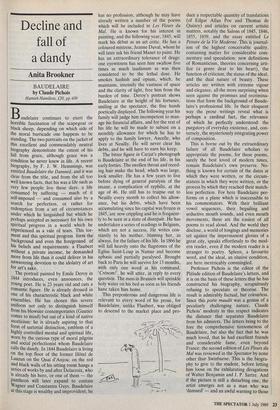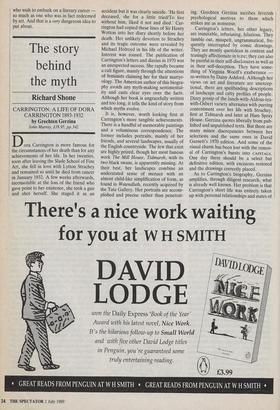Decline and fall of a dandy
Anita Brookner
BAUDELAIRE by Claude Pichois
Hamish Hamilton, £20, pp.430
Baudelaire continues to exert the horrible fascination of the scapegoat or black sheep, depending on which side of the moral barricade one happens to be standing. The two portraits on the jacket of this excellent and commendably neutral biography demonstrate the extent of his fall from grace, although grace was a condition he never knew in life. A recent biography, by F. J. W. Hemmings, was entitled Baudelaire the Damned, and it was clear from the title, and from the all too well known facts, that his was a life such as very few people live these days, a life consumed by suffering — much of it self-imposed — and consumed also by a search for perfection, or rather for redemption from a set of circumstances under which he languished but which he perhaps accepted as necessary for his own spiritual progress in a world which he experienced as a vale of tears. This tor- ment and this spiritual progress form the background and even the foreground of his beliefs and requirements: a Flaubert without a private income, he demanded more from life than it could deliver in his unwavering devotion to the idolatry of art for art's sake.
The portrait painted by Emile Deroy in 1844 introduces, even announces, the young poet. He is 23 years old and cuts a romantic figure. He is already dressed in one of his characteristic black and white ensembles. He has chosen this severe uniform not only to distinguish himself from his blowsier contemporaries (Gautier Comes to mind) but out of a kind of native asceticism: he is already aspiring to that form of sartorial distinction, emblem of a highly controlled mental and spiritual life, worn by the curious type of moral pilgrim and social perfectionist whom Baudelaire calls the dandy. In 1844 Baudelaire is living on the top floor of the former Hotel de Lauzun on the Quai d'Anjou: on the red and black walls of his sitting room hangs a series of works by and after Delacroix, who is already his hero, or one of them — the pantheon will later expand to contain Wagner and Constantin Guys. Baudelaire at this stage is wealthy and improvident; he
has no profession, although he may have already written a number of the poems which will be included in Les Fleurs du Mal. He is known for his interest in painting, and the following year, 1845, will mark his &but as an art critic. He has a coloured mistress, Jeanne Duval, whom he will later ask his friend Manet to paint. He has an extraordinary tolerance of drugs: one eyewitness has seen him swallow five times as much laudanum as was then considered to be the lethal dose. He smokes hashish and opium, which, he maintains, intensify the vastness of space and the clarity of light, free him from the burden of time. Deroy's portrait shows Baudelaire at the height of his fortunes, smiling at the spectator, the fine hands poetically displayed. The following year his family will judge him incompetent to man- age his financial affairs, and for the rest of his life he will be made to subsist on a monthly allowance for which he has to apply to the family lawyer, Ancelle, who lives at Neuilly. He will never clear his debts, and he will have to earn his keep.
The bitter figure in Carjat's photograph is Baudelaire at the end of his life, in his early forties. The swollen throat and reced- ing hair make the head, which was large, look smaller. He has a few years to live before dying of general paralysis of the insane, a complication of syphilis, at the age of 46. He still has to traipse out to Neuilly every month to collect his allow- ance, but his debts, which have been accumulating since his capital was frozen in 1845, are now crippling and he is frequent- ly to be seen in a state of disrepair. He has undertaken a series of readings in Belgium, which are not a success. He writes con- stantly to his mother, blaming her, as always, for the failure of his life. In 1866 he will fall heavily onto the flagstones of the Eglise Saint-Loup in Namur and become aphasic and partially paralysed. Brought back to Paris he will survive for 13 months, with only one word at his command. `Crenomr , he will utter, in reply to every question. The nuns in Brussels will sprinkle holy water on his bed as soon as his friends have taken him home.
This preposterous and dangerous life is relevant to every word of his prose, for Baudelaire, unlike Flaubert, was obliged to descend to the market place and pro-
duce a respectable quantity of translations (of Edgar Allan Poe and Thomas de Quincy) and articles on current artistic matters, notably the Salons of 1845, 1846, 1855, 1859, and the essay entitled Le Peintre de la Vie Moderne. This is journal- ism of the highest conceivable quality, containing matter for considerable com- mentary and speculation: new definitions of Romanticism, theories concerning arti- fice (a genre dear to his heart), the function of criticism, the status of the ideal, and the dual nature of beauty. These articles are written with extreme vigour and elegance, all the more surprising when seen against the promises and recrimina- tions that form the background of Baude- laire's professional life. In their eloquent way the prose writings reveal what is perhaps a cardinal fact, the relevance of which he perfectly understood: the purgatory of everyday existence, and, con- versely, the mysteriously integrating power of composition.
This is borne out by the extraordinary failure of all Baudelaire scholars to appropriate the poems, for these poems, surely the best loved of modern times, remain Baudelaire's own preserve. No- thing is known for certain of the dates at which they were written, or the circum- stances in which they were written, or the process by which they reached their match- less perfection. For here Baudelaire per- forms on a plane which is inaccessible to his commentators. With their brilliant vowel sequences, their beguiling and seductive mouth sounds, and even mouth movements, these are the easiest of all poems to read aloud. And the world they disclose, a world of longings and memories set against the impermanent glories of a great city, speaks effortlessly to the mod- ern reader, even if the modern reader is a stranger to poetry. Spleen, a favourite word, and the ideal, an elusive condition, are here inextricably commingled.
Professor Pichois is the editor of the Pleiade edition of Baudelaire's letters, and it is on the basis of these letters that he has constructed his biography, scrupulously refusing to speculate or theorise. The result is admirably factual, but colourless. Since this poete maudit was a genius of a peculiarly challenging nature, Claude Pichois' modesty in this respect indicates the distance that separates Baudelaire from his admirers. The letters bring to the fore the comprehensive tiresomeness of Baudelaire, but also the fact that he was much loved, that he had excellent friends and considerable fame, -even beyond France: the second edition of Les Fleurs du Mal was reviewed in the Spectator by none other than Swinburne. This is the biogra- phy to give to the student, before letting him loose on the exhilarating divagations of Walter Benjamin and J. P. Sartre. And if the picture is still a disturbing one, the artist emerges not as a man who was `damned' — and an awful warning to those who wish to embark on a literary career so much as one who was in fact redeemed by art. And that is a very dangerous idea to put about.











































 Previous page
Previous page